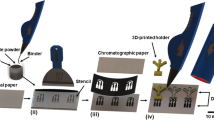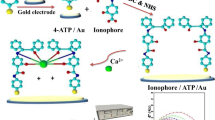Abstract
Salivary levels of Streptococcus mutans and Lactobacillus sp. are important risk factors for dental caries. Application of current test methods is limited because of the requirement for a time-consuming incubation step or expensive laboratory instruments. In this study, we developed a rapid method for determination of the representative cariogenic bacteria, S. mutans and Lactobacillus plantarum, based on a stationary liquid phase lab-on-a-chip (SLP LOC). The method utilized two types of particles, i.e., magnetic capture particles (CPs) for capture of target bacteria and nonmagnetic labeling particles (LPs) for labeling of the captured bacteria with horseradish peroxidase (HRP). Complexes of CP-bacteria-LP were formed in a sample chamber of the LOC and transported to a detection chamber containing the chromogenic substrate of HRP by moving a magnet under the LOC. The method is simple and enabled detection of the two bacteria in a range required for caries risk diagnosis within 40 min without the use of any complicated instruments. Accordingly, this method may have applications in the rapid diagnosis of dental caries risk.
Similar content being viewed by others
References
Stecksén-Blicks, C. Salivary counts of lactobacilli and Streptococcus mutans in caries prediction. Scand. J. Dent. Res. 93, 204–212 (1985).
Krasse, B. Biological factors as indicators of future caries. Int. Dent. J. 38, 219–225 (1988).
McCormack-Brown, K.R. & McDermott, R.J. Dental caries: selected factors of children at risk. Dent. Assist. 60, 10–14 (1991).
Mundorff, S.A., Eisenberg, A.D., Leverett, D.H., Espeland, M.A. & Proskin, H.M. Correlations between numbers of microflora in plaque and saliva. Caries Res. 24, 312–317 (1990).
van Houte, J. Microbiological predictors of caries risk. Adv. Dent. Res. 7, 87–96 (1993).
Baehni, P.C. & Guggenheim, B. Potential of diagnostic microbiology for treatment and prognosis of dental caries and periodontal diseases. Crit. Rev. Oral Biol. Med. 7, 259–277 (1996).
Shi, S., Liang, Q., Hayashi, Y., Yakushiji, M. & Machida, Y. The relationship between caries activity and the status of dental caries—application of the Dentocult SM method. Chin. J. Dent. Res. 1, 52–55 (1998).
Crossner, C.G. Salivary Lactobacillus counts in the prediction of caries activity. Community Dent. Oral Epidemiol. 9, 182–190 (1981).
de Soet, J.J., van Dalen, P.J., Pavicic, M.J. & de Graaff, J. Enumeration of mutans streptococci in clinical samples by using monoclonal antibodies. J. Clin. Microbiol. 28, 2467–2472 (1990).
Shi, W., Jewett, A. & Hume, W.R. Rapid and quantitative detection of Streptococcus mutans with species-specific monoclonal antibodies. Hybridoma 17, 365–371 (1998).
Gu, F. et al. Analyses of Streptococcus mutans in saliva with species-specific monoclonal antibodies. Hybrid. Hybridomics 21, 225–232 (2002).
Cangelosi, G.A., Iversen, J.M., Zuo, Y., Oswald, T.K. & Lamont, R.J. Oligonucleotide probes for mutans streptococci. Mol. Cell Probes 8, 73–80 (1994).
Oho, T., Yamashita, Y., Shimazaki, Y., Kushiyama, M. & Koga, T. Simple and rapid detection of Streptococcus mutans and Streptococcus sobrinus in human saliva by polymerase chain reaction. Oral Microbiol. Immunol. 15, 258–262 (2000).
Igarashi, T., Ichikawa, K., Yamamoto, A. & Goto, N. Identification of mutans streptococcal species by the PCR products of the dex genes. J. Microbiol. Methods 46, 99–105 (2001).
Yoshida, A. et al. Development of a 5' nuclease-based real-time PCR assay for quantitative detection of cariogenic dental pathogens Streptococcus mutans and Streptococcus sobrinus. J. Clin. Microbiol. 41, 4438–4441 (2003).
Nagashima, S. et al. Rapid detection of the cariogenic pathogens Streptococcus mutans and Streptococcus sobrinus using loop-mediated isothermal amplification. Oral Microbiol. Immunol. 22, 361–368 (2007).
Matsumoto, Y., Sugihara, N., Koseki, M. & Maki, Y. A rapid and quantitative detection system for Streptococcus mutans in saliva using monoclonal antibodies. Caries Res. 40, 15–19 (2006).
Kim, M.H. & Choi, S.-J. Immunoassay of paralytic shellfish toxins by moving magnetic particles in a stationary liquid-phase lab-on-a-chip. Biosens. Bioelectron. 66, 136–140 (2015).
Yu, E. & Choi, S.-J. Development of an improved stationary liquid-phase lab-on-a-chip for the field monitoring of paralytic shellfish toxins. BioChip J. 11, 30–38 (2017).
Park, B. & Choi, S.-J. Sensitive immunoassay-based detection of Vibrio parahaemolyticus using capture and labeling particles in a stationary liquid phase lab-on-achip. Biosens. Bioelectron. 90, 269–275 (2017).
Hatton, M.N., Levine, M.J., Margarone, J.E. & Aguirre, A. Lubrication and viscosity features of human saliva and commercially available saliva substitutes. J. Oral Maxillofac. Surg. 45, 496–499 (1987).
Author information
Authors and Affiliations
Corresponding author
Rights and permissions
About this article
Cite this article
Kim, HJ., Choi, SJ. A Rapid Method for Estimation of Cariogenic Bacteria Based on a Stationary Liquid Phase Lab-on-a-chip. BioChip J 12, 52–58 (2018). https://doi.org/10.1007/s13206-017-2107-x
Received:
Accepted:
Published:
Issue Date:
DOI: https://doi.org/10.1007/s13206-017-2107-x




